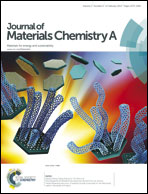TiO2 coated carbon nanotubes for electrochemical energy storage†
Abstract
Metal oxide–carbon architectures (CNTs, graphene, fullerenes, carbon spheres, etc.) have been widely studied due to their outstanding charge storage properties. In this study, we have investigated the charge storage mechanism in TiO2 coated CNTs. TiO2 nanoparticles are anchored to functionalized multiwalled CNTs via controlled hydrolysis of titanium(IV) isopropoxide. The composite architecture thus produced was composed of uniformly coated TiO2 particles (size ranging from 10–30 nm) around the CNTs' surface. The Li-ion storage in TiO2 coated CNTs was investigated using cyclic voltammetry (CV) and galvanostatic charge–discharge experiments. Galvanostatic cycling illustrates a high capacity of 470 mA h g−1 for the composite electrode, a value higher than the theoretical specific capacity (335 mA h g−1) of anatase TiO2. Electrochemical analysis using CV measurements indicates the total charge storage value observed is the cumulative response of diffusion controlled and non-diffusion controlled processes. The repartition of the total charge storage contribution indicates the dominance of Li-intercalation at the peak potential and the capacitive surface reactions at the rest of the potentials in the operating voltage window of 1.5–2.2 V. Hence the nano composite reported here shows the importance of synergistic charge storage contribution from Li-ion insertion and pseudocapacitance resulting in high capacity electrode material.


 Please wait while we load your content...
Please wait while we load your content...